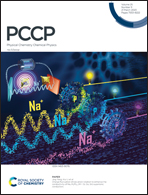Spin Hall effect from bipolaron dynamics in organics†
Abstract
Using an extended Su–Schrieffer–Heeger model and a nonadiabatic dynamics method, we investigate the dynamics of bipolarons in coupled nondegenerate organic chains including the spin–orbit coupling and interchain coupling. By tracing the time-dependent evolution of the charges and spins in each chain, an obvious oscillating spin Hall effect (SHE) from the bipolaron transport is revealed. The results are compared with that from polaron-dominated transport. A reduction of amplitude and an increase of oscillating frequency are observed for the SHE from the bipolaron transport. The mechanism is attributed to the enhanced skew scattering off the larger transient deformations of the chains in the case of the bipolaron. Spectrum analysis by fast Fourier transform of the SHE signal demonstrates a distinct shift of two characteristic peaks to a higher onset frequency compared to the polaron transport. The charge–spin conversion efficiency is also compared, where a larger conversion efficiency is obtained from the bipolaron transport due to the lower saturated velocity. The effects of the strength of the electric field and the interactions are discussed. This work reveals the role of the bipolaron in organic SHE and provides a feasible way to achieve larger conversion efficiency by controlling the species of carriers with the concentration of the dopant.



 Please wait while we load your content...
Please wait while we load your content...